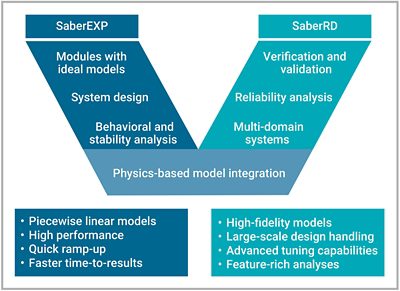Cloud native EDA tools & pre-optimized hardware platforms
SaberEXP and SaberRD
SaberEXP is a piecewise linear (PWL) quick converging simulator for power electronics, with seamless export into SaberRD. With simplified models and minimal simulator calibration parameters, SaberEXP is easier to use and more robust than SPICE-like tools. It is built from PWL numerical methods for systems without integration error, producing faster results for stiff power electronic circuits in both time and frequency domains.
SaberRD adds an integrated design and simulation environment to capture all critical design effects and mechatronic interactions, particularly for power system design. With the proven non-linear Saber simulation technology at it’s core, SaberRD combines ease of use with the power to handle today’s complex electrical power problems, allowing engineers to explore design performance, optimize robustness, and assures system reliability for a broad range of electrical generation, conversion and distribution applications.
Features
SaberEXP Early Design Exploration and High-convergence for Power Electronics
High-speed mixed mode solver: Combines an event queue for event-driven and digital signals with a fast analog PWL solver, caches and reuses recurring circuit topology calculations, analytical solving of temporal signals is based on the circuit time constants.
Generic high-abstraction models: PWL analog models with discrete regions of linear operation in electrical, mechanical, thermal, magnetic, continuous control, and digital domains.
Exporting Designs from SaberEXP to SaberRD
SaberEXP’s high abstraction models and PWL solver provide accuracy and convergence for small to medium complex designs. These designs can be exported into the Saber™ integrated environment for extremely accurate physical modeling and simulation. Design export from SaberEXP into SaberRD is performed through automatic model mapping. SaberRD allows users to further evolve their designs by adding more device specific details for final validation, reliability analysis, and functional safety verification.
Saber Training Videos
A collection of short videos offering technical training and tips for Saber.

SaberRD Virtual Prototyping of Complex Power Electronic Systems
Explore, Measure and Optimize Power System Performance
Simulate the complete system: Capture all the device effects and multi-domain interactions critical to power system design.
High accuracy results, faster: Robust simulation technology and distributed processing capabilities come standard with SaberRD.
Design for robustness and reliability: Built-in capability for analyzing effects of variation, parameter sensitivity, worst-case behaviors, faults, and more.
Unmatched Multi-Domain Modeling Capabilities
Comprehensive libraries: Ready-to-use model libraries include over 30,000 parts to support architectural exploration through detailed physics-level studies of system behavior.
Graphical modeling tools make it easy: From state diagrams and look-up tables to detailed characterizations of power devices and magnetic cores, SaberRD’s suite of modeling tools allows users to quickly create behavioral models of devices and blocks found in power systems and other multi-domain physical systems. Power diode, BJT, MOSFET, and IGBT modeling tools allow you to accurately characterize the advanced Wide Bandgap (WBG) devices such as Silicon Carbide (SiC) and Gallium nitride (GanN) decives in addition to typical silicon devices.
Automotive Powernet Modeling & Simulation Using SaberRD
Simulation tools such as SaberRD can help you model, design, analyze, and optimize the powernet quickly. This video will help you understand the powernet simulation flow along with the advanced modeling, simulation, and post processing capabilities of Saber simulator.
Co-Simulation, Functional Safety and Robust Design Features
Modeling Options and Model Exchange: SaberRD supports industry-standard modeling languages and practices used successfully in automotive, aerospace, and industrial power. SaberRD includes support for Functional Mock-up Interface (FMI), http://fmi-standard.org, and includes the ability to both import and export Functional Mock-up Units to perform system-level Co-Simulation.
SaberRD is the only environment that natively supports MAST and VHDL-AMS, two of the most powerful and widely used hardware description languages for behavioral modeling of power systems.
Functional Safety Analysis According to ISO26262: Design and safety engineers can validate safety levels, fault recovery, and mitigation systems in SaberRD. Users can quickly configure hardware faults by selecting the respective components and nets from the schematic, or by using the automatic fault generator to model various functional safety scenarios. Real-world hazards can be simulated by setting fault timing and injecting multiple faults to match a particular failure mode. An experiment analyzer documents fault coverage and functional safety flows from simulation results.
Monte Carlo and Sensivity: Saber enables system engineers to move beyond nominal design practice to model and simulate how design performance changes with manufacturing variation and shifting operating conditions. The SaberRD configuration includes robust design modeling and simulation capabilities, including Monte Carlo and sensitivity analysis, required to improve system yield and reduce field failures.
Saber Multicore: Saber multicore capabilities parallelizes and distributes iterative simulations across computing resources to dramatically improve throughput and reduce simulation time. The Saber runtime library minimizes the time spent running valuable performance and safety simulations. Engineering and safety teams can simulate thousands of scenarios that would otherwise have been too costly to perform.
Saber Training Videos
A collection of short videos offering technical training and tips for Saber.






